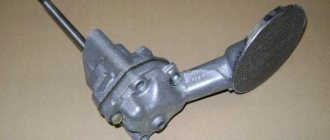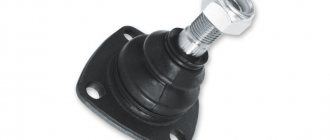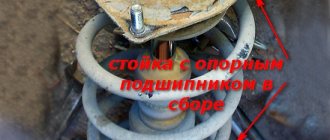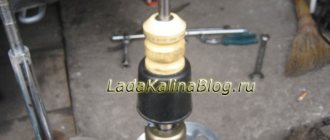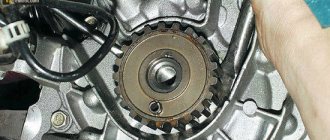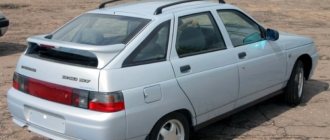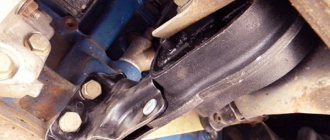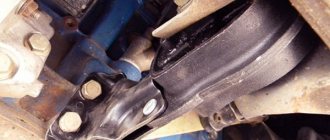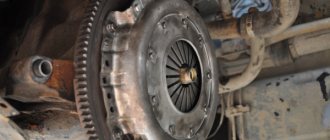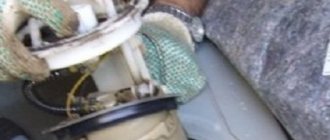Location, principle of operation and design of the pump
The standard VAZ 2106 oil pump, the price of which is quite reasonable, is a product with a gear pair and a shaft installed in the internal cavity of the crankcase pan. This device is held on the cylinder block by 2 fasteners. The drive type gear is rigidly mounted on the shaft, and the driven element, pressed into the body of the product, rotates on the console in free mode.
An oil receiver pipe with a filter mesh and a pressure-reducing valve built into the part is attached to the pump body. An automobile oil pump operates on the following principle: it sucks in engine lubricant and directs it through an oil line running inside the wall of the cylinder block to the oil purification filter. At the exit from the cleaning filter, the aggregate oil spreads further through the main channels and is supplied to lubricate the main and 2 bearings of the vehicle oil pump drive shaft installed on its axle.
It is necessary to install only parts on the “six” that, according to the nomenclature code, correspond to the catalog numbers of the products installed on the vehicle. Thus, the VAZ 2106 oil pump differs from the same products that are mounted on other versions of Volzhsky Automobile Plant cars. They differ from similar parts, for example, in the geometry of the oil intake device, which is adapted to the configuration of the oil pan.
When comparing the design of the VAZ oil pump of the sixth series with analogues for other versions of the VAZ, you can see differences in the linear dimensions of the shaft with splines and gear. If it is necessary to replace the pump due to the mileage between operations, or due to a sharp drop in engine lubricant pressure, then you need to select parts with the designation 2101.
Removing and installing the oil pump
The oil pump is removed for replacement when its supply decreases, causing a constant drop in oil pressure in the engine lubrication system, as well as when oil leaks through the sealing surfaces of the pump housing and cylinder block.
Spare parts only supply the pump assembly, so this section only covers pump removal and installation. The work is shown using the example of the A16 XER engine; on other engines the pump is removed using almost similar techniques.
Repairing an oil pump requires a set of new spare parts, which are not available separately at retail. Therefore, if the pump fails, replace it as an assembly or contact a specialized service for repair.
You will need: all the tools necessary to remove the accessory drive belts and timing gear, the right power unit suspension mount, as well as a TORX T30 wrench and a TORX E12 socket.
1. Disconnect the wire from the negative terminal of the battery.
2. Drain the cooling system (see Replacing the coolant).
3. Remove the accessory drive belt (see Replacing the accessory drive belt).
4. Remove the right power unit suspension mount...
5. ...and the bracket for attaching it to the engine (see Replacing the power unit suspension mounts).
6. Remove the crankshaft pulley...
7. ... auxiliary drive belt tension roller...
8. ...and the lower timing cover (see Replacing the timing belt).
9. Remove the intermediate roller of the timing belt by unscrewing the bolt securing it...
10. ...timing belt...
WARNING
After removing the timing belt, do not rotate the crankshaft and camshafts, as the pistons may damage the valves.
11. ...and the tension roller of the timing belt by unscrewing the bolt securing it (see Replacing the timing belt).
12. Remove the timing pulley from the crankshaft shank.
13. Remove the two bolts securing the water distribution pipe to the water pump.
NOTE
For clarity, the catcollector has been removed.
WARNING
The flange of the water distribution pipe is sealed with a rubber ring. Replace this ring every time the connection is disassembled.
14. Remove the three bolts securing the oil sump to the oil pump...
15. ...nine bolts securing the oil pump to the engine cylinder block...
NOTES
Please note: the oil pump mounting bolts vary in length (bolts A are short, bolts B are long). For clarity, shown with the engine removed
16. ...and remove the oil pump assembly with the water pump.
NOTE
For clarity, shown with the engine removed.
17. Remove the sealing gasket installed under the oil pump housing flange.
NOTE
Replace the oil pump gasket with a new one each time you disassemble the connection, since the old gasket may not ensure a tight connection when reinstalled.
HELPFUL ADVICE
Whenever you remove the pump, replace the crankshaft front oil seal (see Replacing Crankshaft Oil Seals).
18. Install the pump in the reverse order of removal and tighten its mounting bolts evenly crosswise to a torque of 20 N·m (2.0 kgf·m).
19. Install all previously removed parts and fill with coolant (see Replacing the coolant).
HELPFUL ADVICE
When installing a new oil pump, we recommend replacing the oil filter element.
Removal and installation of the oil pump VAZ 2170 Priora
- Repair manuals
- Repair manual for VAZ 2170 (Priora) 2004+.
- Removing and installing the oil pump
The oil pump is removed for repair when its supply decreases, causing a constant drop in oil pressure in the engine lubrication system, and when oil leaks through the sealing gasket.
You will need: all the tools necessary to remove the timing belt and engine oil sump, as well as a 10mm wrench.
1. Disconnect the wire from the negative terminal of the battery.
2. Drain the oil from the engine oil sump (see “Changing the engine oil and oil filter” ).
3. Remove the timing belt (see “Replacing the timing belt and tension roller” ).
| Warning After removing the timing belt, do not rotate the camshaft and crankshaft, as the pistons may damage the valves. |
| 4. Disconnect the wiring harness connector from the crankshaft position sensor. | 5. Using two screwdrivers, remove the pulley from the crankshaft. |
6. Remove the key from the crankshaft groove.
7. Remove the engine oil sump (see “Replacing the oil sump gasket” ).
| 8. Using a “8” wrench, unscrew the three bolts securing the oil receiver... | 9. ...and remove the oil pan. |
| 10. Remove dirt and rinse the oil receiver mesh with white spirit. If the screen cannot be cleaned or is damaged, replace the oil receiver. | 11. Replace the torn or lost elasticity sealing ring of the oil receiver. |
| 12. Remove the six bolts securing the oil pump to the cylinder block, move the oil pump with a screwdriver, inserting it between the pump and the main bearing cap... | 13. ...and remove the pump with the gasket. |
| Helpful Hint: Replace the gasket with a new one each time you remove the oil pump. Install only a factory-made original gasket; a gasket of a different thickness will interfere with the normal operation of the pump. |
14. Clean the mating surfaces of the cylinder block and pump housing from the remnants of the old gasket.
15. Before installation, fill the oil pump cavity with grease to ensure oil suction from the oil sump when the engine is first started.
| 16. Rotate the oil pump drive gear to ensure proper installation on the crankshaft: the lugs on the drive gear should align... | 17. ...with flats on the crankshaft. |
18. Lubricate the seal lip with engine oil. When installing the pump, carefully tuck the working edge of the oil seal onto the crankshaft journal using a wooden stick. After this, tighten the pump mounting bolts.
19. Install all removed parts in reverse order.
20. Adjust the tension of the timing belt (see “Replacing the timing belt and tension roller” ).
21. Adjust the tension of the generator drive belt (see “Replacing the generator drive belt” ).
22. Fill the engine with oil (see “Changing engine oil and oil filter” ).
| Helpful Hint When installing a new or refurbished oil pump, we recommend replacing the oil filter. |
↓ Comments ↓
1. Car structure
1.0 Car structure 1.1 General information about the car 1.2 Passport data 1.3 Car keys 1.4. Controls 1.5. Heating and ventilation of the cabin 1.6 Ensuring a comfortable air temperature in the cabin 1.7. Doors 1.8. Passive safety equipment on the car 1.9. Seats
2. Recommendations for use
2.0 Recommendations for use 2.1. Safety rules and recommendations 2.2 Running in the car 2.3 Operating the car during the warranty period 2.4. Preparing the car for departure
3. Problems along the way
3.0 Malfunctions along the way 3.1. The engine does not start 3.2 Malfunctions of the fuel injection system 3.3 Idle speed has disappeared 3.4. Interruptions in the operation of the 3.5 engine. The car moves jerkily 3.6 The car accelerates poorly 3.7 The engine stalled while driving 3.8. Oil pressure dropped to 3.9. Engine overheating 3.10. The battery does not recharge 3.13. Knocks in the engine 3.16. Wheel puncture
4. Maintenance
4.0 Maintenance 4.1. General provisions 4.2. Inspection work 4.3. Lubrication and filling works 4.4. Diagnostic work 4.5. Repair and adjustment work
5. Engine
5.0 Engine 5.1 Design features 5.2 Possible engine malfunctions, their causes and solutions 5.3 Useful tips 5.4 Checking compression in the cylinders 5.5 Removing and installing the decorative engine casing 5.6 Removing and installing the engine splash guard 5.7 Installing the piston of the first cylinder to the TDC position of the compression stroke 5.8 Replacing the drive belt gas distribution mechanism and tension roller 5.9 Replacing the power unit supports 5.11. Replacing engine seals 5.13. Engine cylinder head 5.15. Engine repair 5.16. Lubrication system 5.17. Cooling system 5.18. Power supply system 5.19. Design Features
6. Transmission
6.0 Transmission 6.1. Clutch 6.2. Gearbox 6.3. Front wheel drives
7. Chassis
7.0 Chassis 7.1. Front suspension 7.2. Rear suspension
8. Steering
8.0 Steering 8.1 Design features 8.2 Possible steering malfunctions, their causes and solutions 8.3. Steering column 8.4. Steering linkage 8.5. Steering gear
9. Brake system
9.0 Brake system 9.1 Design features 9.2 Possible malfunctions of the brake system, their causes and solutions 9.3 Bleeding the brake system hydraulic drive 9.4 Removing and installing the vacuum brake booster 9.5 Replacing the brake pedal axle bushings 9.6. Main brake cylinder 9.7. Front wheel brakes 9.8. Braking mechanisms of the rear wheels 9.9. Pressure regulator 9.10. Brake hoses and tubes 9.11. Parking brake
10. Electrical equipment
10.0 Electrical equipment 10.1 Design features 10.2. Battery 10.3. Mounting block (relays and fuses) 10.4. Generator 10.5. Starter 10.6. Ignition switch (lock) 10.7. Electronic engine control system (ECM) 10.8. Ignition system 10.9. Lighting, light and sound signaling 10.10. Windshield cleaner 10.11. Washer reservoir 10.12. Electric fan of the engine cooling system 10.13. Electric motor of the heating and ventilation system fan 10.15. Cigarette lighter 10.16. Instrument cluster 10.18. Electronic anti-theft remote control system 10.19. Immobilizer 10.21. Replacing sensors and switches
11. Body
11.0 Body 11.1 Design features 11.2 Possible body malfunctions, their causes and solutions 11.3 Removing and installing windshield frame lining 11.4 Removing and installing soundproofing upholstery in the engine compartment 11.5. Removing and installing bumpers 11.6 Removing and installing the fender liner and protective wing cover 11.7 Removing and installing the front fender 11.8 Removing and installing decorative sill trims 11.9. Hood 11.10. Trunk lid 11.11. Doors 11.12. Seats 11.13. Seat belts 11.14. Rear view mirrors 11.15. Interior fittings 11.16. Instrument panel 11.17. Heater 11.20. Body care
12. Applications
12.0 Appendix 12.1 Appendix 1. Tightening torques of threaded connections, Nm 12.2 Appendix 2. Fuels, lubricants and operating fluids 12.3 Appendix 3. Nominal filling volumes 12.4 Appendix 4. Basic data for adjustments and monitoring 12.5 Appendix 5. Spark plugs used on vehicles 12.6 Appendix 6. Lamps used on a car 12.7 Appendix 7. What you need to have in a car 12.8 Appendix 8. Tools used when repairing a car
13. Electrical diagrams
13.0 Electrical Diagrams 13.1 Diagram 1. Instrument Panel Harness Connections 13.2 Diagram 2. Vehicle Front Wire Harness Connections 13.3 Diagram 3. Engine Electronic Control System (ECM) Harness Connections 13.4 Diagram 4. Vehicle Rear Wire Harness Connections 13.5 Diagram 5. Light Harness Connections license plate light 13.6 Diagram 6. Left front door wiring harness connections 13.7 Diagram 7. Right front door wiring harness connections 13.8 Diagram 8. Rear door wiring harness connections
Repair
If you have the desire and time, you can repair the unit, because this is not a VAZ pump, which cannot be restored. There is nothing complicated in such work. For repairs you need a small number of tools:
- wrenches 10 (open-end, box, socket);
- ruler;
- set of probes (flat);
- vice.
Replacing the drive gear in this vehicle unit
Replacing the oil pump on a VAZ-2112 16 valves photo, video
If a red indicator lights up on your instrument panel, signaling a lack of oil pressure in the system, then do not rush to run to the store and buy a new oil pump.
The video discusses the most basic reasons why oil pressure may drop in a VAZ engine:
Replacing the oil pump
There is nothing difficult about replacing an oil pump. We drive the car into the pit, prepare the tools and get to work.
- Disconnect the battery.
Removing the battery terminal for repair - Drain the oil into the prepared container (stopper on the tray).
The plug is unscrewed with a key - We jack up the car, place it on a good stand (a stump will do just fine) and remove the right wheel.
- Remove the timing belt.
Timing belt without casing. - Remove the crankshaft pulley and key (you will need an assistant to clamp the flywheel with a screwdriver).
- Remove the crankcase cover.
Removing the pallet - We remove the oil intake itself.
- We clean the oil receiver grid (with solvent or kerosene).
- And directly remove the oil pump itself (6 bolts on the cylinder block).
The location of the 6 bolts that secure the oil pump is marked with arrows
Reassemble the oil pump in reverse order.
The pan and oil pump gaskets must be replaced with new ones. Also, the new oil pump should be washed out of preservative grease and filled with oil (to prevent it from running dry during the first start after repair).
Why is an oil pump needed?
Pump appearance
The oil pump in the engine is designed to build up pressure in the oil system, for the necessary lubricating effect of all rubbing parts of the internal combustion engine. If the pressure in the system is insufficient, the lubrication effect will be ineffective, which in turn will lead to the engine being unsuitable for operation. In this case, the low oil pressure warning light on the instrument panel should light up. Therefore, you should not delay repairing the oil pump.
You are left with two options. Take the car to a service station and lose a lot of time and money, or change the oil pump yourself.
Pump diagnostics
Oil pump removed for diagnostics. Symptoms: oil leak.
First, you need to make sure that the oil pressure sensor itself is working properly - check whether the sensor itself is dry or oily.
Secondly, you need to check whether power is supplied to it correctly or whether a wire is broken somewhere. And only after these procedures, if the light does not go out, will you have to change the oil pump.
Why might it break prematurely?
An oil leak from the oil pump can lead to expensive engine repairs.
Replacement of the oil pump can also be caused by poor quality oil, which will lead to rapid clogging of the oil receiver grid and subsequent lack of oil pressure in the system. It is not uncommon for an oil pump to become wet and oil to leak from underneath it. In these cases, you can get by by replacing the gasket and cleaning the oil receiver mesh.
In general, the oil pump does not bring much trouble to VAZ-2112 owners. It is designed for 120 thousand kilometers. When purchasing a new pump and spare parts for its repair, choose original spare parts. The official manufacturer of oil pumps for the VAZ-2112 is the Tolyatti Plant (TZA).
Reasons for the drop in oil pressure in VAZ cars
Instrument panel and oil pressure warning lamp
If the pressure drops, then, as mentioned above, a special light on the instrument panel begins to signal a problem. To begin with, it is recommended to check the entire circuit that is transmitted from the sensor to the warning lamp:
- take the wire from the sensor and lean it against the engine ground (if the circuit is in good order, the lamp will definitely go out);
- if everything is fine in the circuit, you need to remove the oil pressure sensor (if it is dry, then there is a problem, which you need to look for below).
And quite often it is the oil pump that causes the malfunction. The oil filter valve or some other element may be stuck in this part. By replacing a low-quality oil filter with a high-quality option, you can solve the problem. But if the pressure drops again, then you need to open the pan and check the oil receiver, and then the rubber sealing ring. If this does not help, you need to remove and disassemble the oil pump itself.
Replacing the oil pump on a VAZ 2109, 2108
The power plant of a modern car is equipped with several pumps. They can be called “hearts”, each of which pumps a specific liquid - fuel, antifreeze or oil. Today we will talk about one of them – oil. Since it is impossible to diagnose this unit without partially disassembling the motor, the condition of the pump is determined by indirect signs.
If it malfunctions, events most often unfold as follows: the oil pressure warning light lights up on the instrument panel. The car enthusiast checks its level and sees that it is normal (or adds oil if necessary), but the lamp does not even think of going out, which leads to the need to troubleshoot.
There can be many reasons why the light comes on, but most likely the oil pressure sensor is broken or something is wrong with the pump. In this article we will tell you how to correctly replace this unit on a VAZ-2109 and other cars of this family.
Where is the oil pump on the VAZ 2109
Its location is behind the crankshaft pulley. As a result of this circumstance, it will not be possible to get to it without removing some parts, in particular, the pulley itself and the oil pan. Below is a photo showing the oil pump in its seat.
When to change the oil pump
If the pump fails, the following things happen:
- The oil pressure drops, as a result of which the corresponding control light on the dashboard lights up.
- Oil consumption increases, and it constantly has to be topped up (however, this does not always happen).
How to replace the oil pump on a VAZ 2109, 2108, 21099
Tools:
Before you begin the replacement, prepare all the necessary tools. This is a set of wrenches, a set of sockets, a universal joint and an extension. If the pump is replaced with a new one, then buy the necessary spare part (its catalog number is “2108-1011010″). Also, drive the car into a hole or overpass, otherwise it will be very difficult for you to get to the pump.
Removal:
1) Remove the crankshaft position sensor. It should be noted that this is only relevant for an injection engine; if the engine is carburetor, skip this point.
2) Drain the engine oil.
3) Next, remove the timing pulley.
4) Now you can remove the oil pan. Then find the oil receiver and unscrew the bolts that secure it, and then remove it.
5) Take a socket of the required size and an extension, and use them to unscrew the 6 bolts that secure the oil pump to the engine block
Be extremely careful as there are washers under the bolts and it is very important not to lose them
6) Ideally, after step 6, the pump should be removed, but in practice this does not always happen. If this is your case, take a thicker screwdriver, insert it between the pump and the main bearing and gently wiggle it (remember, do not damage the bearing!).
7) Carefully remove the oil pump.
Installation:
1) Before you install a new unit, perform one very important procedure. You need to find the drive gear and turn it like this... (continued below)
2) So that its position coincides with the special flats located on the crankshaft.
3) Now take some engine oil and lubricate the front crankshaft oil seal (more precisely, its working edge).
4) Is the oil seal lip lubricated? Install the pump onto the crankshaft. For this you will need an ordinary pencil. It will be needed to tuck the oil seal into its place (this must be done strictly with the unsharpened end of a pencil!). After this, screw back the 6 bolts securing the oil pump, not forgetting the washers.
5) Now reassemble the remaining parts in the reverse order of removal. Archive important!
Since you will have to remove the timing belt to get to the timing pulley (and at the same time the radiator along with a number of other parts), be extremely careful with the crankshaft when changing the pump.
It must not be allowed to rotate at a significant angle, otherwise the pistons have every chance of meeting the valves, as a result of which they may become deformed, and this will lead to dire consequences.
Dismantling
Depending on the situation, the oil pump can be completely replaced, or repair work can be performed - change gears, return the pump pressure reducing valve to functionality.
Pressure reducing valve
But let's talk about everything in order. In any case, work begins with dismantling the oil pump.
- Before you remove the pan to gain access to the pump, you will definitely need to drain the oil.
- To do this, warm up the engine to operating temperature, open the drain hole and wait until all the liquid drains out.
- Draining can also be done when it is cold, but due to its high viscosity, the oil can flow for a very long time and most of it will still remain inside the crankcase.
- After draining the oil, remove the three mounting bolts from the crankcase protection using an 8 mm wrench. The protection blocks access to the flywheel near the crankcase.
- Remove the flywheel guard and then remove the bolts from the crankcase. That's it, now the crankcase can be removed.
- In front of you is the crankshaft and the oil sump where the desired pump is located.
- By unscrewing the three mounting bolts, you can remove the intake from the pump.
- Let's move on to the engine compartment. Lift the hood and remove the plastic cover. This is a guard that covers the timing belt.
- Next, you need to remove the front right wheel to remove the pulley fixing washer, and then remove the pulley itself.
- Remove the timing belt and remove the six mounting bolts that hold the oil pump in place. Here you will need an 8 mm wrench.
- Remove the oil pump from the crankshaft.
Removing the cover
Disassembly
If you do not want or cannot yet purchase a new pump, you can try to repair it. Perhaps the problem is a malfunctioning valve or worn gears.
- Remove the gasket from the pump;
- Remove the bolt holding the crankshaft position sensor;
- By unscrewing the six mounting bolts, you can remove the cover from the pump;
- Using a pair of screwdrivers, lift the housing so that the pins on it come out of their holes freely;
- Remove the body, disconnect it from the cover;
- Now you need to remove two gears from the cover. The drive gear is removed first, and then the driven gear is removed;
- Next in line is the pressure reducing valve. You need to unscrew the plug under which the o-ring is located;
- Check the condition of this seal. If the ring shows signs of damage or is too squeezed out, be sure to replace it with a new one;
- Remove the valve spring;
- Now you can remove the valve itself. To do this, gently tap the case on a stand made of pure wood;
- The valve may be stuck. Do not worry. Take any thin, sharp object, pry it up and remove the element. It is better not to use metal objects so as not to damage the surface;
- Check the current condition of the aluminum cover. If there are deep scratches or signs of wear, replace it;
- If the pump body shows signs of wear, do not even try to repair anything. The only correct solution would be to completely replace it;
- You also need to make sure that the gears and the diameter of their sockets comply with the standards;
- The maximum diameter of the driven gear socket is 75.1 millimeters. If it is larger, the case must be replaced;
- Measure the width of the body in the middle. If the indicator is less than 3.4 mm, it is worn out and needs to be replaced;
- As for the thickness of the gears, according to the requirements, the thickness of the drive is at least 7.42 mm, and the driven one - 7.35 mm. In case of deviations from the norm, the gears are changed.
Removing the gear
The oil pump must be removed from the engine in the following order:
- Remove the distributor cover and turn the crankshaft to a position in which ball 2 on the flywheel (mark “MZ”) is installed against the edge of pin 1 fixed in the inspection hatch of the clutch housing, and the distributor rotor plate is directed towards the housing terminal to which the low-voltage wire is connected. voltage from the ignition coil.
- Unscrew the union nut and disconnect the vacuum tube from the fitting of the ignition distributor regulator chamber. Disconnect the low voltage wire from the terminal on the distributor body, loosen the bolt of the clamp securing the distributor in the cylinder head socket, and remove the distributor.
- Remove the oil sump.
- Unscrew the two bolts securing the pump housing flange to the bottom plane of the cylinder block and remove the pump. Installation of the oil pump into the engine is carried out in the reverse order. It must be taken into account that the oil pump drive gear must be engaged with the camshaft helical gear in a strictly defined position.
This is necessary to ensure correct mutual connection of the ignition distributor drive shaft with the pump shaft, since the position of the distributor vacuum regulator housing relative to the cylinder head casing depends on this.At the upper end of the pump drive shaft there is a shank 1, which fits into the slot of the distributor shaft. When installing the pump correctly, shank 1 should be positioned perpendicular to axis 2 of the crankshaft when the piston of the first cylinder is at idle. compression stroke. To install the pump correctly, you need to rotate its drive shaft so that shank 1 is approximately parallel to axis a, connecting the two holes attaching the pump to the cylinder block, as shown by the line.
When installing the pump in place, do not rotate its housing. When the pump drive gear engages with the camshaft gear and rotates through a certain angle, the pump shaft shank will take the correct position. When installing the pump on the engine, it is necessary to install a new paper gasket between the pump housing flange and the bottom plane of the cylinder block. After installing the oil pump and distributor, adjust the initial ignition timing and secure the distributor body in the required position using the clamp bolt. If the oil pump and initial ignition timing have been set correctly, then after fixing the distributor, its vacuum regulator will take the position shown in the figure.
- Reinstall the oil pan.
Replacing the oil pump on a VAZ 2110
Obviously, the oil pump (OP) in the VAZ 2110 car system serves to transport the lubricant.
It’s not uncommon that when you get behind the wheel and start the engine, a warning light with an image of an oil can lights up on the dashboard and does not go out. In this case, the likely cause of the signal may be a failed pump.
troubleshooting
Don't rush to conclusions and blame the pump for everything. It is necessary to organize a full check to make sure what caused the signal to appear on the dashboard.
Check area
Your actions
You need to check the functionality of the electrical circuit that goes from the sensor to the instrument panel. The wire that goes from the regulator to the engine must be connected to ground. If the circuit is working properly, the lamp will go out.
Checking the oil filter
Just unscrew the oil pressure sensor. If it is soaked in lubricant, everything is fine. If it is dry, then the filter is clogged or the filter valve is stuck.
Checking internal elements
You will need to replace the filter if there is a problem with it. Next, the pan is opened and the condition of the oil receiver and rubber seals are inspected.
If the measures taken did not produce results, the lamp still does not go out, then the pump is the culprit in the current situation.
Useful information
Let's talk a little about the principles of the design and operation of the oil pump. This can help you during the repair process.
- Domestic “tens” use a combined lubrication system.
- The design of the car provides for the presence of a gear oil pump. It is installed on the front end of the cylinder block.
- Special gears with trochoidal internal gearing help reduce mechanical losses during rotation.
- The pump is equipped with a full-flow filter with a non-separable design. It contains an anti-drip and bypass valve.
- This design guarantees efficient circulation of lubricant throughout all engine components.
- The pump operates by rotating the crankshaft. The connection is direct.
- The operating life of the pump is about 120 thousand kilometers.
Location
Not everyone knows where to look for this oil filter. It is not located in a visible place, so you will have to try hard to gain access to the device.
The MN is located directly inside the engine oil sump. To get to it, the oil must be drained from the engine.
Element location
Please note that if your engine uses high-quality oil that was only recently filled, use a clean container when draining it so that you can then refill the same substance. If the oil is old, replacing the pump is an excellent reason to change the lubricant.
Dismantling
Depending on the situation, the oil pump can be completely replaced, or repair work can be performed - change gears, return the pump pressure reducing valve to functionality.
Pressure reducing valve
But let's talk about everything in order. In any case, work begins with dismantling the oil pump.
- Before you remove the pan to gain access to the pump, you will definitely need to drain the oil.
- To do this, warm up the engine to operating temperature, open the drain hole and wait until all the liquid drains out.
- Draining can also be done when it is cold, but due to its high viscosity, the oil can flow for a very long time and most of it will still remain inside the crankcase.
- After draining the oil, remove the three mounting bolts from the crankcase protection using an 8 mm wrench. The protection blocks access to the flywheel near the crankcase.
- Remove the flywheel guard and then remove the bolts from the crankcase. That's it, now the crankcase can be removed.
- In front of you is the crankshaft and the oil sump where the desired pump is located.
- By unscrewing the three mounting bolts, you can remove the intake from the pump.
- Let's move on to the engine compartment. Lift the hood and remove the plastic cover. This is a guard that covers the timing belt.
- Next, you need to remove the front right wheel to remove the pulley fixing washer, and then remove the pulley itself.
- Remove the timing belt and remove the six mounting bolts that hold the oil pump in place. Here you will need an 8 mm wrench.
- Remove the oil pump from the crankshaft.
Removing the cover
Disassembly
If you do not want or cannot yet purchase a new pump, you can try to repair it. Perhaps the problem is a malfunctioning valve or worn gears.
- Remove the gasket from the pump;
- Remove the bolt holding the crankshaft position sensor;
- By unscrewing the six mounting bolts, you can remove the cover from the pump;
- Using a pair of screwdrivers, lift the housing so that the pins on it come out of their holes freely;
- Remove the body, disconnect it from the cover;
- Now you need to remove two gears from the cover. The drive gear is removed first, and then the driven gear is removed;
- Next in line is the pressure reducing valve. You need to unscrew the plug under which the o-ring is located;
- Check the condition of this seal. If the ring shows signs of damage or is too squeezed out, be sure to replace it with a new one;
- Remove the valve spring;
- Now you can remove the valve itself. To do this, gently tap the case on a stand made of pure wood;
- The valve may be stuck. Do not worry. Take any thin, sharp object, pry it up and remove the element. It is better not to use metal objects so as not to damage the surface;
- Check the current condition of the aluminum cover. If there are deep scratches or signs of wear, replace it;
- If the pump body shows signs of wear, do not even try to repair anything. The only correct solution would be to completely replace it;
- You also need to make sure that the gears and the diameter of their sockets comply with the standards;
- The maximum diameter of the driven gear socket is 75.1 millimeters. If it is larger, the case must be replaced;
- Measure the width of the body in the middle. If the indicator is less than 3.4 mm, it is worn out and needs to be replaced;
- As for the thickness of the gears, according to the requirements, the thickness of the drive is at least 7.42 mm, and the driven one - 7.35 mm. In case of deviations from the norm, the gears are changed.
Removing the gear
Assembly and installation
If you managed to repair the oil pump, then all that remains is to assemble it and install the unit in place. If you decide to completely replace the device, skip the first part of the further instructions.
- Install the driven gear onto the housing with the chamfers on the teeth.
- Also, the new pump drive gear is returned into place using chamfers on the teeth.
- Be sure to remember to lubricate the gears with oil so that they work more reliably and longer.
- Replace the pump cover and screw back all the fasteners.
- Lubricate a new or repaired old relief valve before installing it in its proper place.
- The valve fits into its seat. Make sure installation is done bottom down.
- Now it’s the turn of the spring and the plug, which is wrapped with an o-ring. Again, these elements are pre-lubricated with engine oil.
- Using the oil pickup tube, oil is poured back into the unit.
- Once assembly is complete, rotate the pump gears several full turns. This will ensure effective lubrication of all surfaces inside the pump.
The unit is assembled and can be returned to its place. For this:
- Return the timing belt to its place by pulling it onto the rollers. Don't forget to set according to the labels;
- Return the plastic belt protection to its rightful place, install the wheel;
- Now you need to crawl under the car to install the oil pick-up on the pump;
- Be sure to treat the crankcase with compounds, removing all fat. Treat with sealant;
- We recommend installing a new gasket on the crankcase, after which another layer of sealant is applied;
- The block is degreased, the crankcase is returned to its rightful place;
- To make it easier to attach it, tighten several bolts at different points, and then screw in all the rest;
- Protection is installed on the flywheel, the crankcase protection is returned to its place;
- Pour oil back into the system, start the engine, and allow the oil to distribute throughout the components.
Reassembly
If you carry out all the manipulations correctly and first determine that it is the pump that has failed, the warning light on the dashboard will go out.
The oil pump plays a huge role in the functioning of the engine’s lubrication system, so at the first sign of its breakdown, immediately go to the garage, or entrust the replacement to specialists from trusted service stations.
Eliminating oil leaks
Many models of saws experience oil pump malfunctions during their operation. The nature of these defects may vary, but ultimately this leads to an oil leak. Moreover, such leaks can appear even when the saw is in a lying position. Oil pump pf-43 on a chainsaw and its design. Why doesn't the oil pump work? This is justified by the uneven distribution of water in the storage tank.
Leaks also occur due to the fact that oil pumps for chainsaws have a fitting on their own body for attaching a hose. A loose connection between the water tank and the pump may result in oily droplets.
Such difficulties can be solved by disassembling the saw and repairing the oil pump.
The disassembly process should be approached very carefully so as not to destroy the moving parts of the pump. The following tools will also be useful for this:
In most cases, all chainsaw oil pumps consist of 2 main halves. In one half there is a working mechanism, and in the second there is a storage chamber.
The video discusses repairing a chainsaw
and its sealing in the housing. And this is a similar video.
If the pump leaks, it is necessary to replace the gasket between the two parts of the mechanism.
For repairs, you should disassemble the unit into halves, without touching the working part. There should be a gasket at the junction. Hello everyone, tell me how to remove the oil pump and replace it like in a chainsaw. In this case, if it has huge compressed areas, then the gasket needs to be changed.
If the gasket is not bad, then it should be wiped and replaced. Then the hose is checked. There should be no cracks or diaper rashes on it that will disturb its density. As a rule, when the engine operates normally at low speeds, the oil pump. If similar defects are detected, the hose must be replaced. How to change the oil pump in an alligator chainsaw at home, you will need a few tools and desire, everything is very simple, support our channel in any way you can. If the hose is not bad, then it needs to be washed, degreased and sealed.
Then all output channels are checked, in which there should be no third-party inclusions (garbage, slag, etc.). How to change the oil pump in an alligator chainsaw at home, replacing the oil pump. This debris will lead to congestion, which will create vacuum plugs. If they are detected, the channels should be cleaned. This can be done with compressed air.
Preventive measures
In order to reduce the possibility of various oil leaks while using the saw, it should be periodically serviced. During this process, it is necessary to monitor the tightness of all hoses and gaskets. How does a chainsaw oil pump work | husqvarna. If they are detected, the connecting parts should be pulled.
It is imperative to inspect the quality of the oil being poured. It must be of high quality and used in strict accordance with the features indicated in the product passport. With all this, under no circumstances can you use mining, since it has a heterogeneous structure. Also, it is imperative to do repeated purging of the oil pump. How to remove the oil pump of a Huskvarna chainsaw, kak-snyat-maslyanyiy-nasos-benzopilyi-huskvarna. This will help prevent debris from coking in its working channels.
Low quality lubricating water will worsen the quality of the tool and reduce its service life.
In addition, if the lubrication is poor, the chain may fail, replacing which will be a rather expensive procedure.
After performing sawing work, it is necessary to make sure to clean the saw from any sawdust that has fallen on it. Oil pump; Generally, the oil pump consists of two on the surface should not. During long breaks in work, the chainsaw should be hung in a vertical position. This will allow the oil water to spread moderately throughout all the channels of the instrument. Such uniform distribution will avoid vacuum plugs, which can cause oil pump malfunctions.
